
11 Top Most Popular Software Development Methodologies
Software development methodologies are nothing but different product organization methods for your software development workflow.
All methodologies have their strengths and limitations and work differently in different situations. Therefore, to effectively handle your specific software development project, you need to choose the correct software development methodology that will provide smooth development.
Being an experienced and bespoke software development company, we know all the different methodologies used for software development. To help you choose the suitable method, we have made a comparison of the most popular software development methodologies.
Let’s get started knowing the 11 latest software development methodologies.
Table of Contents
What is Software Development Methodology?
Software development methodology is a set of rules to structure, plan, and control the process of developing a software system or solution. The software methodologies are similar to blueprints for the entire software development process, outlining stages and tasks to be accomplished.
A software methodology even describes who is responsible for what tasks in the entire process and describes timelines for completion.
Let’s go through list of different software development methodologies.
11 Best Software Development Methodologies in 2025
Here is the top modern software development methodologies list to look for in 2025.
- Agile Development Methodology
- DevOps Deployment Methodology
- Waterfall Development Method
- Rapid Application Development Methodology
- Feature-driven development (FDD) Methodology
- Scrum Methodology
- Extreme Programming Methodology
- Lean Development Methodology
- Prototype Methodology
- Spiral Methodology
- Joint Application Development Methodology
Agile Software Development Methodology
Agile software development is a software engineering methodology which is used to design a process of disciplined software management that often enables the development project to shift regularly. This software development approach is a systematic structure for conducting different projects using programming methodologies in software engineering.
Agile separates work into distinct phases called sprints. Each sprint lasts a few weeks, during which a list of deliverables is pursued by team members. The agile development team members check the task, along with the Scrum master, as the sprint finishes.
Agile methodology is the most used software development methodology.
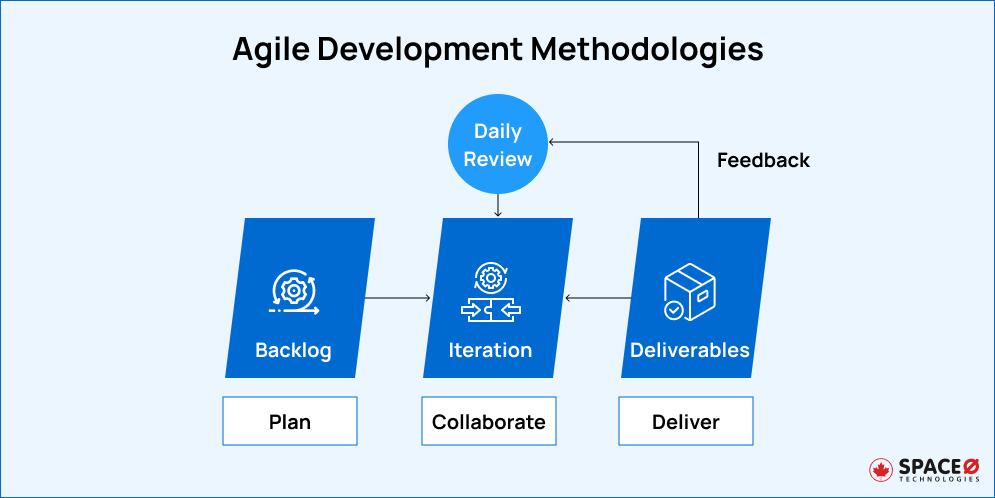
If you’re looking for a framework for agile development that can help you deal with the volatile marketplace dominated by consumers, then you can definitely consider implementing the philosophy of Agile software development.
Pros & Cons:
Pros Cons - Highly adaptive approach
- Low risk
- Direct communication and high transparency
- Frequent releases and feedback collection
- Early release of a working product
- Early detection of defects and fixed for a fraction of the cost
- Great customer satisfaction
- Not ideal for beginners and inexperienced developers
- Lacks documentation efficiency
- Need extensive training to understand project process
- Need constant attention, otherwise, the agile development project can lose the track
DevOps Deployment Methodology
DevOps is not only a methodology for development but rather a series of activities that sustain an organizational culture. The DevOps methodology focuses on operational reform that strengthens coordination between the divisions responsible for various parts of the development life cycle, such as development, quality assurance, and operations.
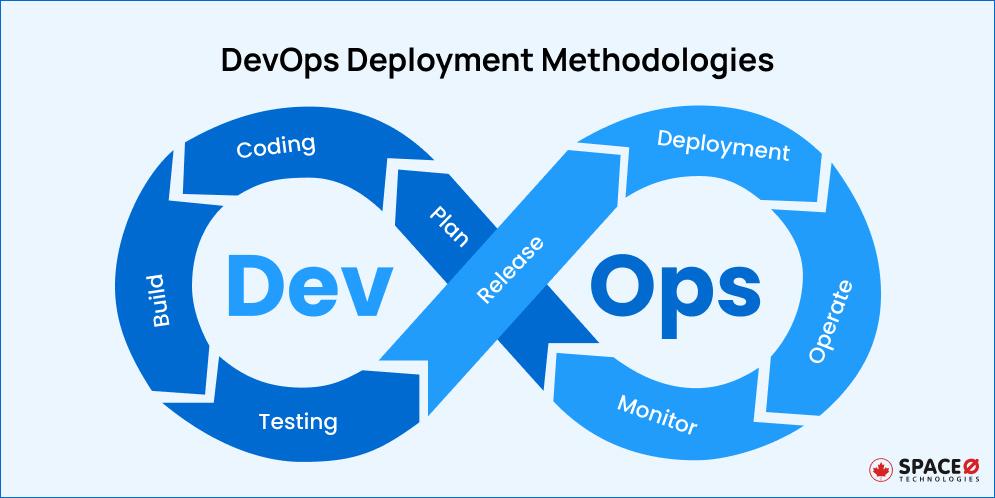
So, if you’re the founder of a technology startup and looking for a quicker way to build software or want to create a series of effective testing procedures, then DevOps would be the right choice for your startup.
Pros & Cons:
Pros Cons - Rapid and continuous delivery of working software
- Deploy new processes, systems, and applications easily
- Fewer chances for mistakes as the software development team is working closely
- Improves the customer experience
- Continuous integration
- Reliability with increasing changes
- Collaborative platform
- Accountability and ownership
- Minimizes disruption
- DevOps demands culture change
- Require a lot of human interaction
- Require extensive testing
- Need high skilled developers
Waterfall Development Methodology
The waterfall methodology is a rigid linear model consisting of sequential phases based on multiple targets (requirements, design, execution, verification, maintenance). Each step must be 100 percent completed before the next step can start. It means, no reversible modifications can be made in the waterfall development for any requirements.
As the cycles are long and are very inflexible, this model is also known as a heavyweight technique. The waterfall method does not accept change but it consists of special features to make it unique.
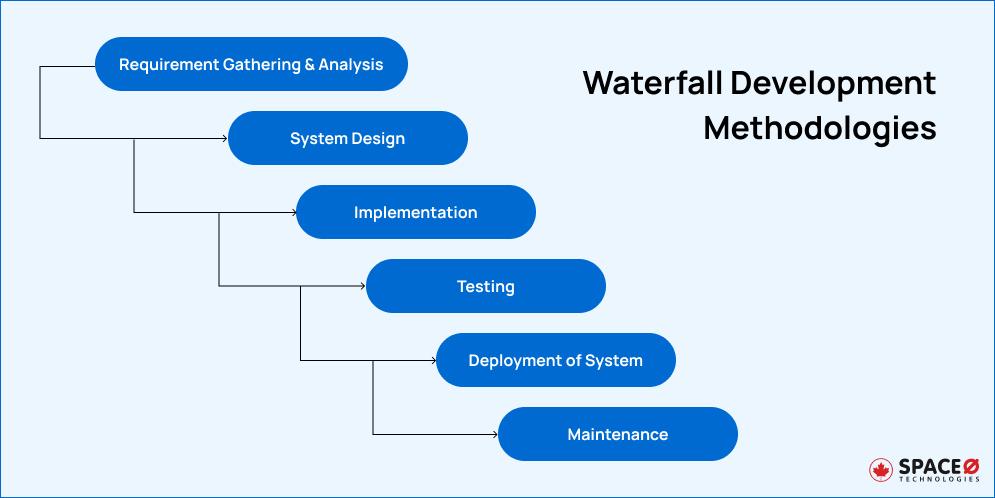
The waterfall method is mostly used by plan-driven teams who have a very good view of the nature of the project. However, with the versatility and mobility of more modern methodologies, development teams who do not work in a gap can generally find better outcomes with the Waterfall model. That’s why Waterfall is one of the top software development methodologies for developing applications with very clear requirements.
Pros & Cons:
Pros Cons - Easy to understand and straightforward
- Best for a small team size of business
- Simple enough to manage the project process
- Saves a lot of time
- Easy testing and analysis
- Fixed deadline for each project
- Faster delivery
- Can not go back to change or modify
- The waterfall approach can not handle large risks
- Not suitable for large software projects
- Hard to measure the outcome before the delivery
Rapid Application Development Methodology
Rapid Application Development (RAD) is an efficient application development methodology that promises much faster development and outcomes of better product quality than those obtained by different types of development methodologies. It is designed in such a manner that a software developer will conveniently take full advantage of it. The key aim of this software development technique is to speed up the whole software development process.
There are four steps in the rapid application development methodology: planning, user design, building, and switchover. The processes of user design and development repeat until the user agrees that all requirements are fulfilled by the product.
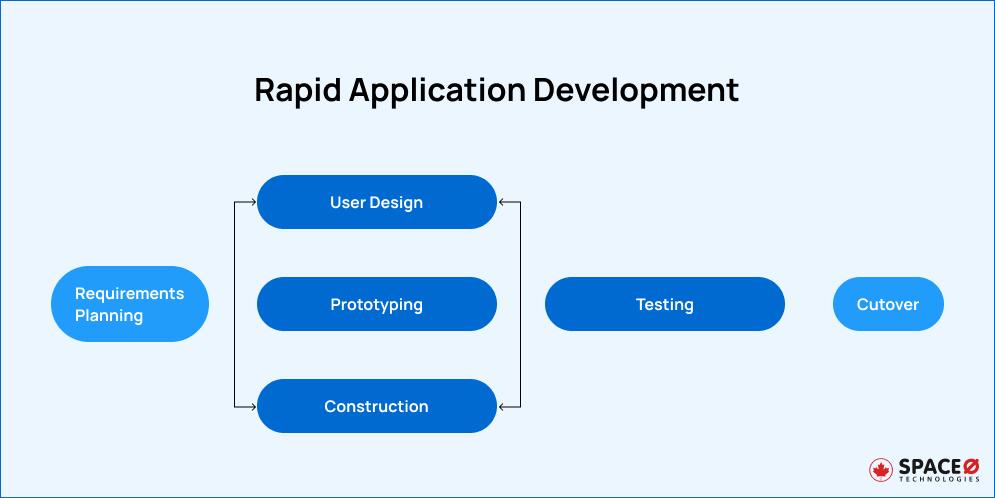
If your market priorities are well-defined and limited, then you should go for Rapid Application Development (RAD).
Pros & Cons:
Pros Cons - Easy to understand
- Reduced risk
- Fewer efforts
- Minimizes the errors in the system development process
- Easy to collect feedback from customers for improvement
- Delivers the high functionality
- Proved to be the best for small to medium size projects
- No ideal for low budgets
- Demands highly skilled developers
- Not suitable for large software engineering projects
- Hard to track the progress and problems
- Works on modularized system
- Highly dependent on the performance of the team
Feature-driven development (FDD) Methodology
Feature Driven Development Methodology is an iterative approach for software development designed for large teams using object-oriented programming operating on a project.
FDD has five phases and out of which the first is to build an overall model. After that, create a list of features and then schedule each feature accordingly. The final two phases will take up much of the time, plan by feature and create by feature. Status monitoring is recommended at each stage and helps monitor improvement, consequences, and potential mistakes.However, before starting with the development it is recommended to write software requirement specifications to have a clear vision of features.
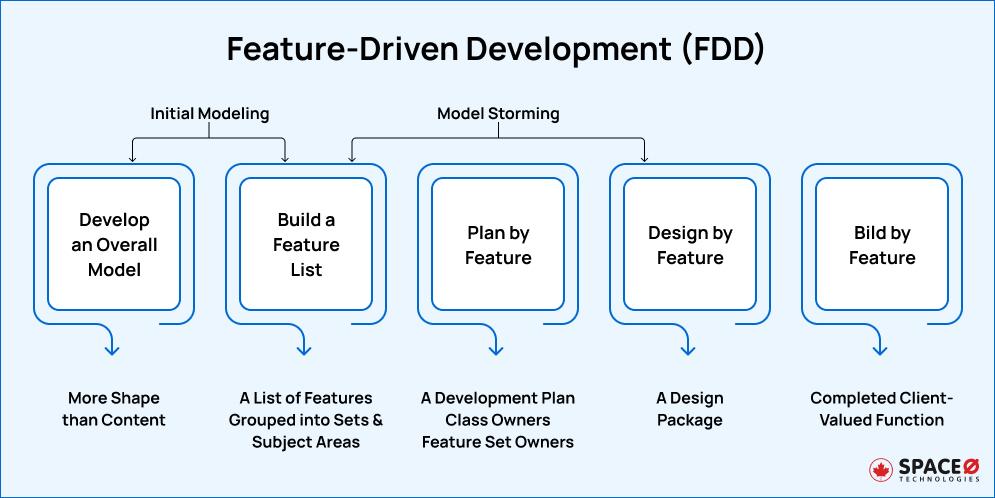
For a development organization transitioning from a phase-based development approach to an iterative approach, this type of model is perfect.Pros & Cons:
Pros Cons - Rapid system development
- Multiple teams can work simultaneously
- Easy to obtain repeatable success
- It follows software development industry-recognized practices
- Provides greater output with 5 step software development procedure
- Not suitable for smaller projects
- Not ideal for an individual developer
- No documentation
- Success depends on the leaders and main project manager
Scrum Methodology
The Scrum software development methodology can be used in virtually all project forms. As a phase of software development, it starts with a brief plan for each sprint, followed by regular scrum meetings that demonstrate the success of the project, and concludes with final analysis.
The software project methodology of Scrum is suitable for conducting tasks with customer input and specifications that are not clearly described. Using this approach that makes a sequence of prototypes in a single go, software development companies can speed up app development.
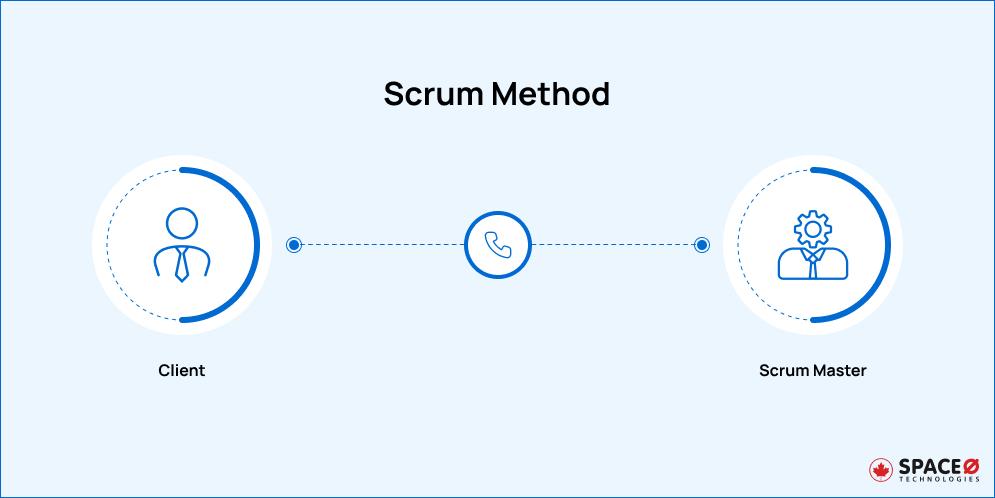
The Scrum approach is most suitable for the management of projects with customer input and specifications that are not clearly defined. Teamwork, openness, and frequent status reports allow the success of the project to be accelerated.
Pros & Cons:
Pros Cons - Frequent release
- Frequent meetings and sessions that enhance productivity
- Extremely flexible approach
- Customer feedback and review process collection is easy and fast
- Delivers quality product
- Errors can easily be identified
- Easy to cope with changes
- Documentation is not compulsory due to its flexible nature
- Not ideal for junior or mid-level developers
- Need constant communication
- Scales poorly for large teams
- Frequent team composition changes make it hard to determine the productivity
Extreme Programming Methodology
Another agile software development methodology framework that focuses on the development of higher-build quality applications using best software development practices in software development is Extreme Programming (XP). Extreme Programming methodology encourages occasional launches in quick production sprints and, as in most Agile strategies, it facilitates improvement when appropriate.
In particular, extreme programming (XP) methodology embraces a series of principles rather than steps, including simplicity (developing software on what is needed, nothing more); collaboration (teams need to cooperate on development tools and function together); consistent feedback; and consideration.
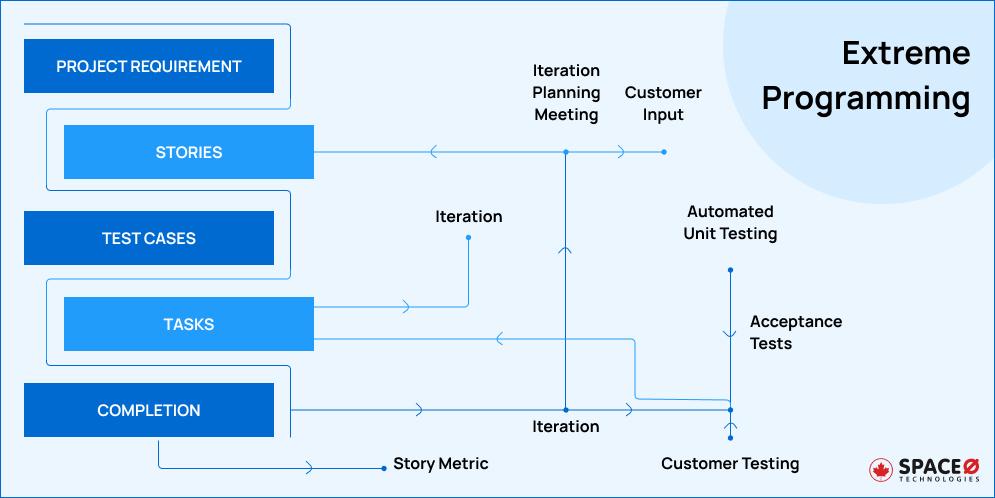
This approach provides developers with the provision to provide a finished product at a reduced investment cost. Around the same time, due to the daily sessions, test-driven methodology, and pair programming, a lot of human activity end up slowing down the delivery pipeline.Pros & Cons:
Pros Cons - Cost-effective
- High focus on planning and task scheduling
- Great for small as well as large teams
- Effective risk management
- High transparency
- Works best in an unstable environment
- Emphasize customer involvement
- Easy to develop high-quality software
- Requires frequent meetings
- Too many development process changes
- The future outcome is uncertain
- Demands 100% dedication
Lean Development Methodology
The lean development methodology emphasizes the development of easily manageable applications as a technological progression. This exquisitely crafted technique of development is more purposefully integrated than any other form of agile methodology.
This approach is designed to develop the software one-third of the time, with a relatively small budget and a much smaller volume of the essential workflow. This is done by removing everything that does not contribute many benefits to the process of test-driven development.
Lean is a software development workflow technique and a mindset at once, integrating industrial space concepts and standards and extending them widely to a number of sectors, including software development.
Pros & Cons:
Pros Cons - The speedy software development process
- Efficient budget control
- Best for early-stage startups
- Easily eliminate the waste
- Improves decision-making ability
- Delivers high-quality product
- Greater flexibility
- Highly depends on the project development team involvement
- Not effective, if there’s no right business analyst in the team
- Can easily lose focus due to excessive flexibility
Prototype Methodology
The Prototype approach is the phase of product development that requires developers to create only the prototype of the app product to show its features to consumers. They envision how it will work and show to investors or customers its purpose.
In order to build the final mobile application, the developers subsequently make all the requisite adjustments in preparation. This technique provides space for the comprehension of software development criteria and the execution of valuable market research.
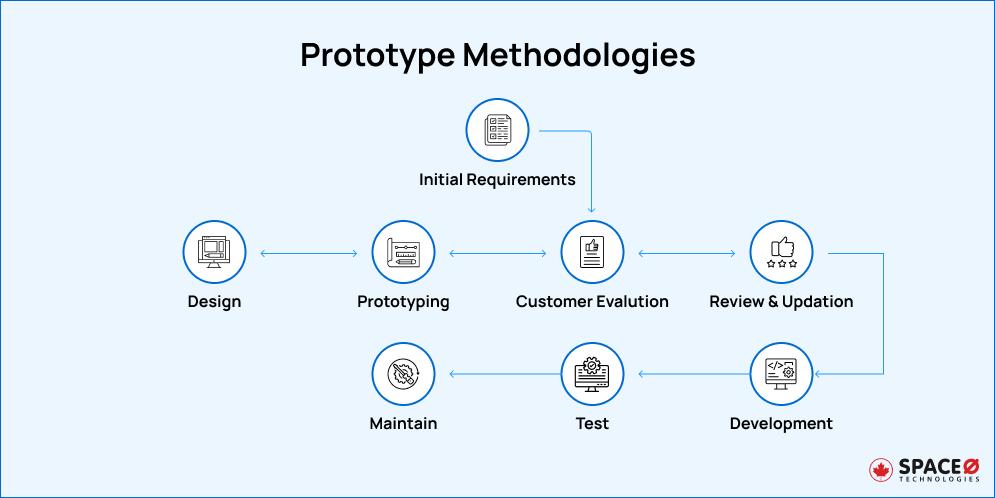
The strongest attribute of this approach for software development is that it addresses a multitude of problems that sometimes arise in a typical waterfall life cycle model.
Pros & Cons:
Pros Cons - Early identification of risks
- Easy business requirements documentation gathering and planning
- Reduced risk
- Clear idea about the project process
- Better communication
- An effective approach to demonstrate the product to a client
- High project management cost
- Excessive client involvement affects the process
- Not ideal for projects where too many modifications required
Spiral Methodology
The spiral software development model is the combination of Agile and waterfall methodology that mostly focus on early risk detection and mitigation.
The developers start on a small scale, then explore the project risks, make a risk management strategy, and eventually determine whether to take the next phase in the project to do the next iteration of the spiral. Performance of any Spiral Lifecycle Model depends on the project’s efficient, diligent, and competent management.

The spiral approach helps the developer to make improvements in the code or design even in the testing stage, in comparison to the waterfall model. It is appropriate for almost all types of projects, however effective management is needed.
Pros & Cons:
Pros Cons - Fewer risk factors
- Works best for large scale projects
- Easy cost estimation
- Easy access to additional functionality
- Develops quality products
- Not appropriate for low-risk projects
- Costly Model
- If risk analysis is not conducted properly, the project may get damaged
Joint Application Development Methodology
Joint application development is a technique for the development of standards and user interfaces in which end-users, stakeholders, and engineers hold intensive off-site sessions to hammer out and finalize software applications. The goal of this approach is to include the customer in an application’s design and creation.
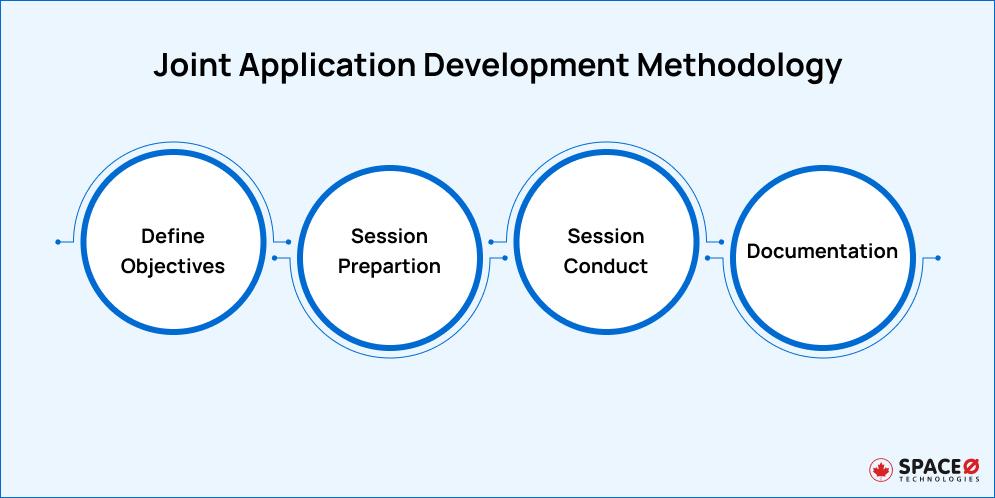
With a series of interactive seminars, JAD sessions quickly achieve end goals. Instead of technological information systems, the key purpose of this dynamic systems development model is to fix the business issue. Initially, this approach was developed for computer-based applications but has been successfully used for all sorts of development processes.
Pros & Cons:
Pros Cons - Collaboration between company and client reduces risks
- Favorable assistance
- Provides a forum to explore multiple points
- Improved system quality
- Information system is produced in a short span of time
- Takes a lot of time to deliver the product
- Demands high skilled engineers
- Different points of view
Stuck on deciding the right methodology for your product software?
We have an expert team to guide you.

Ready to build an app for your business but don’t know what methodology to apply?
Our software developers can help.
So these are the different types of software development methodologies. Now, if you are wondering how to choose the right one for your project, check the next section.
How to Choose the Right Software Development Methodology for Software Development?
The above-mentioned 11 modern methodologies for software development are the most used in the software development process. Each one works well in different situations; depending upon the project requirements.
Here are some of the points to know for choosing the right methodology.
- Evaluate your business requirements
- Define your target audience
- Check the project size
- Evaluate the development timeframe
- Consider the location of the development team
The points mentioned above, help you to choose the right software development methodology.
However, each of these latest software development methodologies have certain pros and cons; so selecting one ultimately depends on the project requirements and project scope.
Let’s develop a software product using the most suitable method for your business profits.
Frequently Asked Questions
What are SDLC methodologies?
- Agile
- Waterfall
- Iterative
- Spiral
- Kanban
- DevOps
Which is currently the most commonly used software development methodology?
Within the list of software development methodolgoies, Agile, Scrum, Rapid application development methodology, and Waterfall are among the most famous and commonly used software engineering methodologies for the various kind of development.
Conclusion
Technology has paved the way for unique inventions, and software development workflows are no different. The key thing is that it deals with a number of complexities, involving expert handling. The latest technologies in software system development have defined methodologies that work on such platforms, giving them the ability to operate.
Thus, before choosing any of these software engineering methods for your software development projects, you must have knowledge of all these methodologies. However, it is highly recommended to contact one of the top software development companies in Canada for improved results. All the best!
Editor's Choice
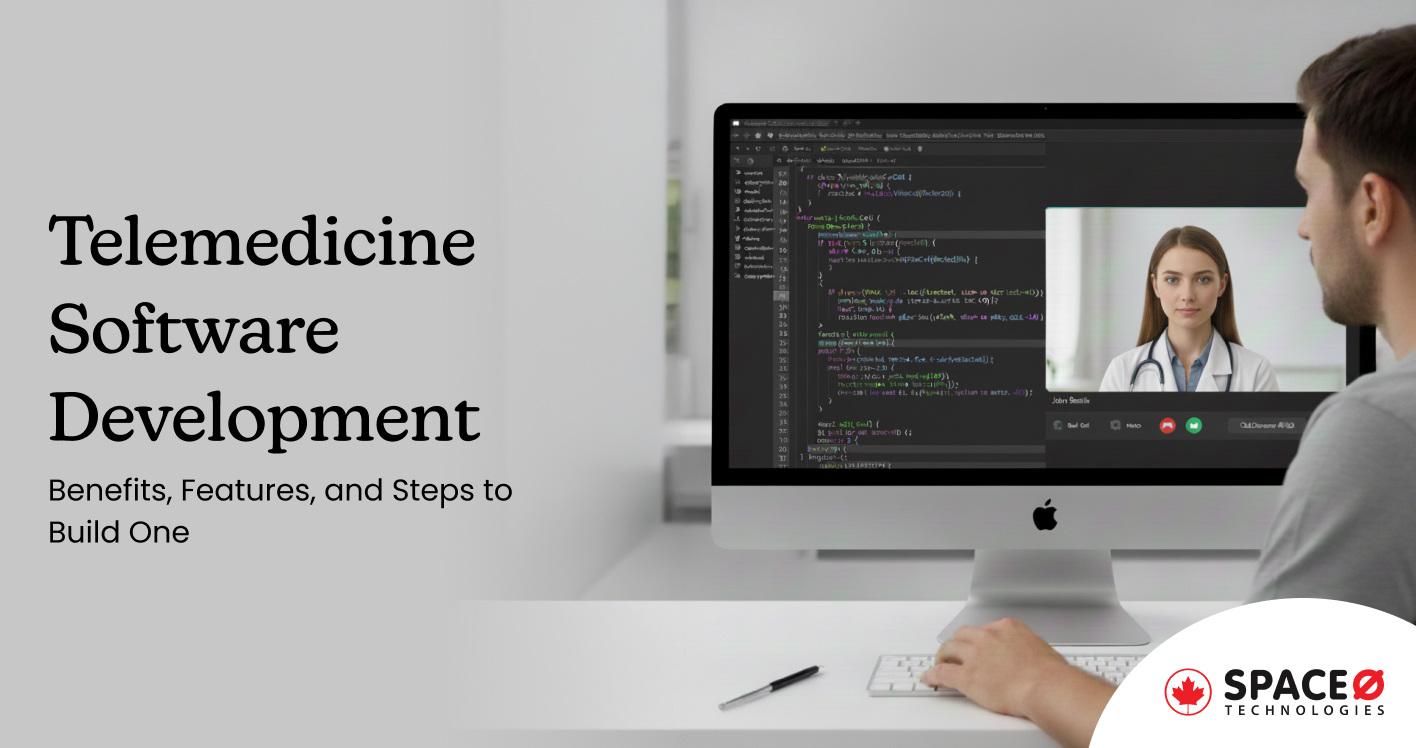
Telemedicine Software Development: A Complete Guide to Building Remote Healthcare Platforms
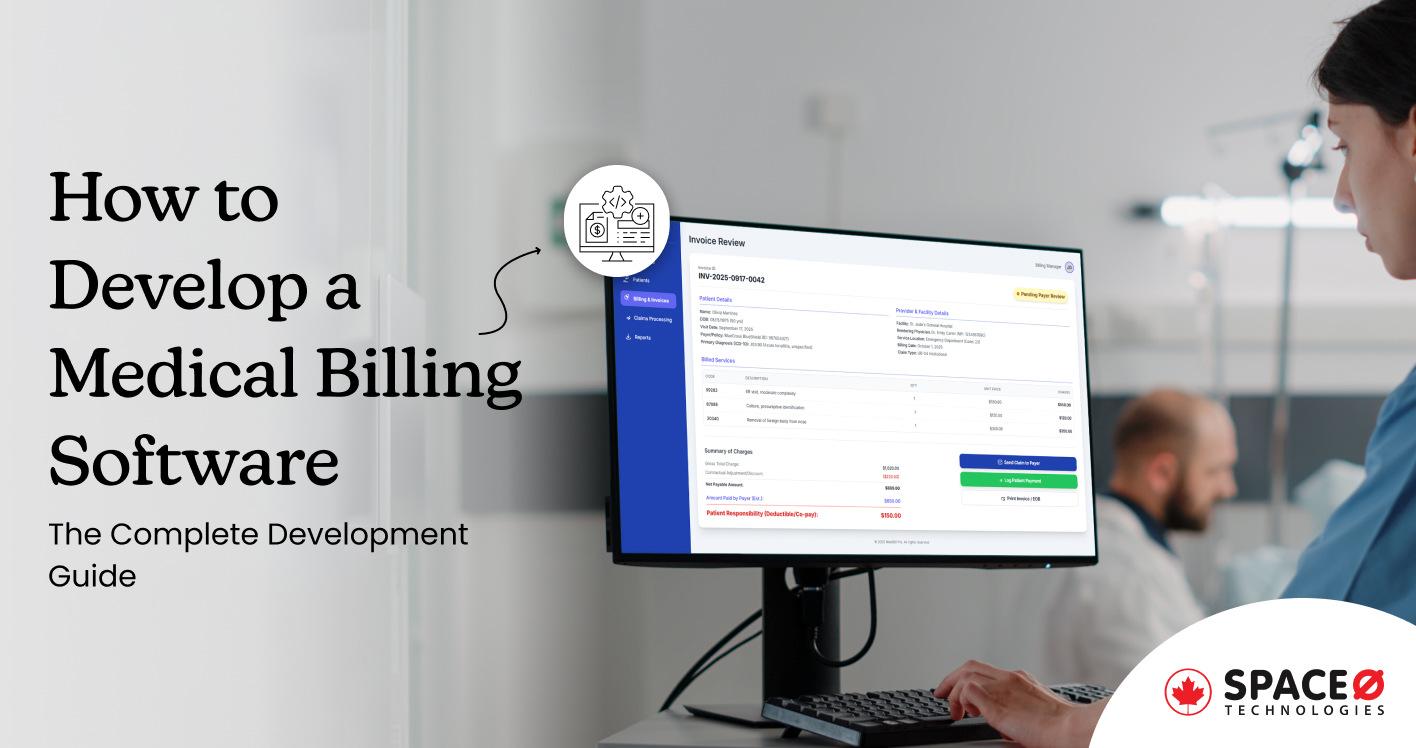
Medical Billing Software Development: The Complete Guide for Healthcare Providers
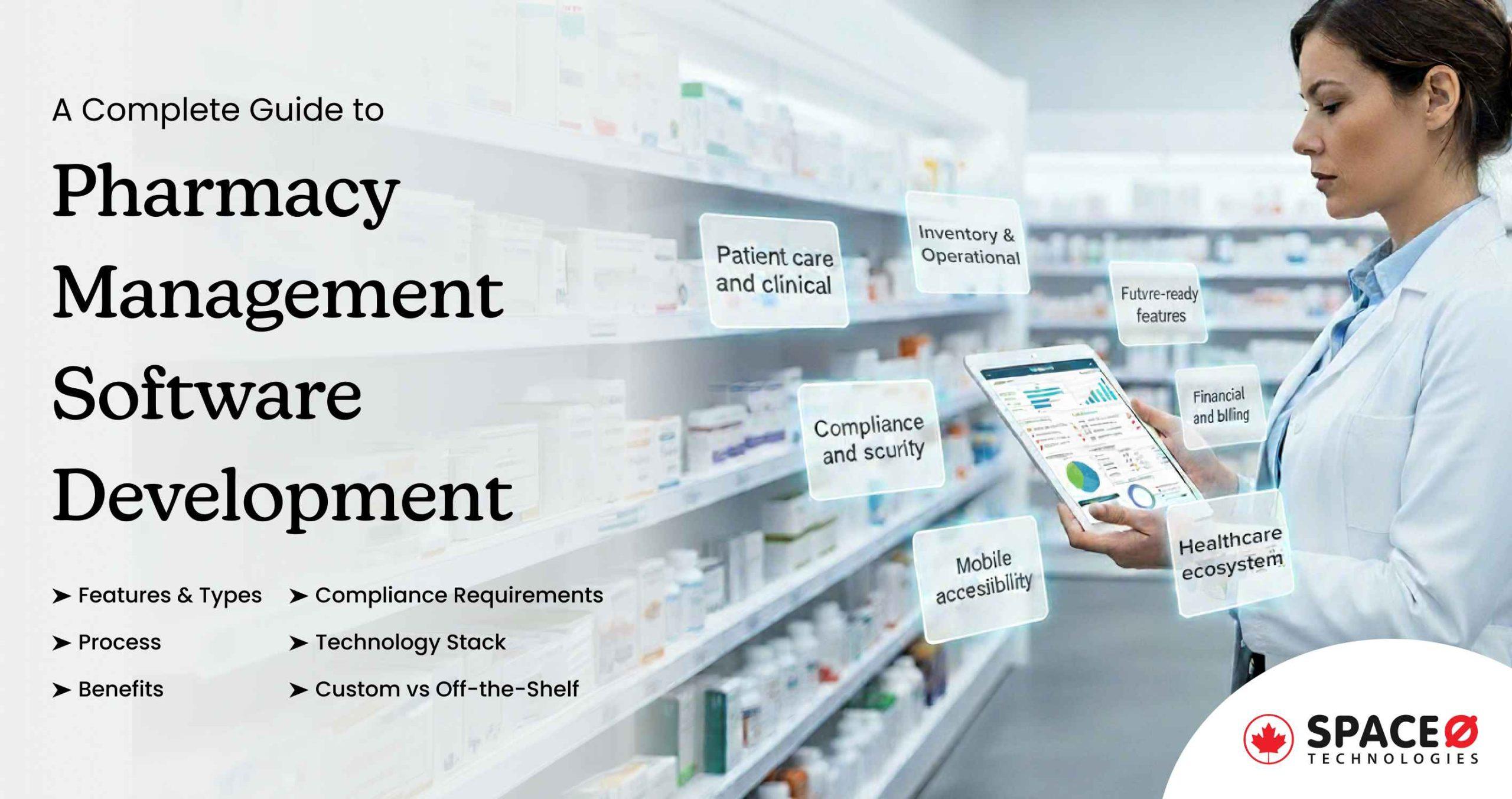
A Complete Guide to Pharmacy Management Software Development
All our projects are secured by NDA
100% Secure. Zero Spam
*All your data will remain strictly confidential.
Trusted by


Bashar Anabtawi
Canada
“I was mostly happy with the high level of experience and professionalism of the various teams that worked on my project. Not only they clearly understood my exact technical requirements but even suggested better ways in doing them. The Communication tools that were used were excellent and easy. And finally and most importantly, the interaction, follow up and support from the top management was great. Space-O not delivered a high quality product but exceeded my expectations! I would definitely hire them again for future jobs!”

Canada Office
2 County Court Blvd., Suite 400,
Brampton, Ontario L6W 3W8
Phone: +1 (437) 488-7337
Email: sales@spaceo.ca


